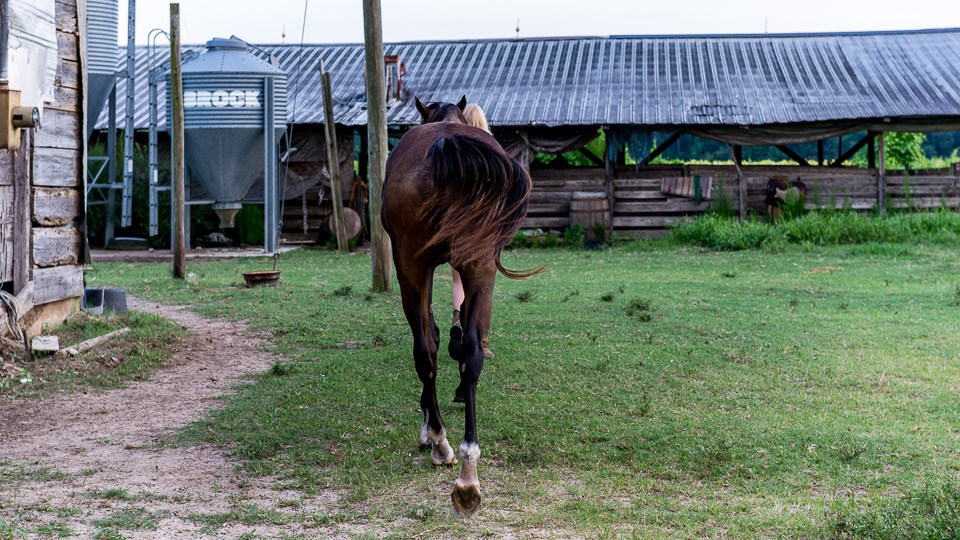
Horsemanship – Irrefutable Law 4
Place yourself between the horse and the exit. This is an interesting concept that needs to start with a story or two.
I was finished working on a horse and the owner wanted to take the mare outside to the paddock. She reached up and grabbed the horse by the halter which prompted me to ask her if she knew she was breaking the first 3 laws of my 10 Irrefutable Laws Of Horsemanship. She dismissed me with a look. I reminded her of Law 1, a horse can kill you; Law 2, the horse that will kill you is your own; law 3, always use a lead rope. She broke into my lecture with another dismissive “Don’t worry about me Doc, I’ve done this a hundred times.” Away she went with the horse about to break Law 4, always placing yourself between the horse and the exit.
**CONTINUED IN ARTICLE TAB**
Related material – Sometimes I have a lot of material here that I have written, podcasted, video blogs and other things. They will be listed in this tab.
Use the browser back button or menu to return to the index of topics.
⬇︎ CLICK ANY IMAGE BELOW TO REVEAL MORE INFORMATION ⬇︎ There are no images
Place yourself between the horse and the exit. This is an interesting concept that needs to start with a story or two.
I was finished working on a horse and the owner wanted to take the mare outside to the paddock. She reached up and grabbed the horse by the halter which prompted me to ask her if she knew she was breaking the first 3 laws of my 10 Irrefutable Laws Of Horsemanship. She dismissed me with a look. I reminded her of Law 1, a horse can kill you; Law 2, the horse that will kill you is your own; law 3, always use a lead rope. She broke into my lecture with another dismissive “Don’t worry about me Doc, I’ve done this a hundred times.” Away she went with the horse about to break Law 4, always placing yourself between the horse and the exit.
I cleaned up my gear as she led the horse away. She returned with both hands covering her face and blood streaming everywhere. Luckily the hind hoof had just touched her nose causing it to bleed but it could have been worse. She could have been dead. The toughest part was running to the house to get her husband. The best part was when she said to me, “Doc, you were right. I will play by the rules from now on.” And she has for 10 years.
When my client had gotten to the open gate into the paddock she just let go and allowed the horse to run past her into the field. In the horse’s excitement she had kicked out just touching her nose. This is how NOT to turn a horse loose in any area including the stall. Instead there are 3 rules to follow:
- Walk through the opening connected to the horse with a lead to the halter then turn the horse around so that you are between the horse and the opening.
- Wait until the horse is relaxed and listening to you.
- Remove the lead and turn away from the horse BEFORE he turns away from you. If you need to remove the halter then the same applies. Be sure you are leading the dance. In other words YOU are leaving the horse and not the other way around. This is leadership and the horse will recognize this.
So many people have the horse leave them on their own terms. If you let your child out of the car when they wanted to before the car came to a complete stop and the surroundings checked for danger you would be considered an irresponsible parent. When my client broke all 3 rules above she paid a price. It only takes a moment more to do this correctly. Remember, this is about SAFETY and taking these moments to teach those around you who are watching and looking to you for instruction on how to do things without getting hurt. So what if you have done this a hundred times. The first time with the new horse you might get a surprise.
A corollary to this law is when you are working on a horse in a confined space like a stall or grooming area. There are times when you need to get behind the horse for cleaning or examining. By definition this law will be broken. The bad possibilities include the horse leaves the stall or the horse gets spooked and kicks you into the wall for a double injury. It is possible so why take the chance? Tying up the horse to a solid structure will prevent the horse from leaving. But working behind a loose or tied horse is still placing you behind the horse. In this case you have a few choices.
- The first is to remain aware. I see people all the time zoned out when working around the horse. They act surprised when the horse suddenly moves when I could see the horse thinking about moving half a minute before.
- The next best thing is to remove the horse from the stall to clean it. For an examination, remove the horse from the stall so you are not between the horse and a solid wall. For grooming work your way towards the hind end making sure you and the horse are listening to each other.
- Having someone hold the horse by the head and standing on the SAME side the other person is always a good idea. Having the head holder on the same side makes sense because if the horse starts to act up, the person on the lead can pull the head TOWARDS the other person which will automatically move the hind end of the horse away from the person. It is extremely difficult for a horse to kick if you are pulling their head sideways. By the way, I never trust the person on the head of a horse. It is still my responsibility to maintain a physical and mental connection with the horse at all times.You need to move the moment something is about to happen and before the head holder can react.
This physical law is broken more than any other as I observe people working with their horses. There is an assumption that their horse will neither leave them or they will never kick them. But I have seen both happen so why take the chance? Working with this rule will minimize either of these two things happening and it will also teach those with less experience watching you the more correct way of working with horses. And they are always watching.
- Additional tables
- Links to other in house articles
- Links to outside articles
- Reference material used in developing this topic.
There are no related articles here if you don’t see linked items.


Responses